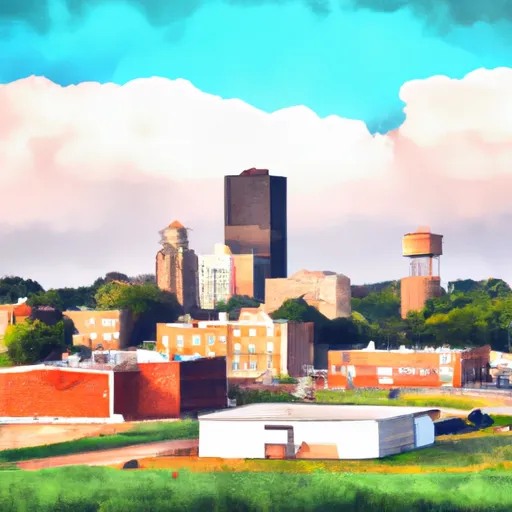-
 Snoflo Premium
Snoflo Premium
Get unlimited access to all our content
With no Ad interruptions! - Start Your Free Trial Login with existing account
Tamaroa
Eden Index
Climate
8.3
•
Recreation
2.8
•
Community
0.8
•
Safeguard
4.5/10

Tamaroa is a small village located in Perry County, Illinois, known for its picturesque natural surroundings and vibrant outdoor recreation opportunities. The climate in Tamaroa is characterized by hot and humid summers, with temperatures often reaching the mid-90s Fahrenheit, and cold winters, where temperatures can drop below freezing. The area experiences moderate rainfall throughout the year.
The hydrology constituents in Tamaroa are primarily influenced by the Big Muddy River, which flows through the village. This river provides a scenic backdrop and offers opportunities for fishing, boating, and kayaking. The river is home to various fish species, including catfish, bass, and crappie, making it a popular spot for anglers.
Outdoor recreation enthusiasts can also enjoy exploring the Shawnee National Forest, located nearby. This lush forest offers a multitude of activities, such as hiking, camping, and wildlife watching. Visitors can immerse themselves in the beauty of nature while traversing the trails and observing diverse flora and fauna.
In summary, Tamaroa, Illinois, boasts a climate with hot summers and cold winters, while the hydrology constituents revolve around the Big Muddy River. The village provides ample opportunities for outdoor activities, including fishing, boating, hiking, camping, and wildlife watching in the nearby Shawnee National Forest.
What is the Eden Index?
The Snoflo Eden Index serves as a comprehensive rating system for regions, evaluating their desirability through a holistic assessment of climate health, outdoor recreation opportunities, and natural disaster risk, acknowledging the profound impact of these factors on livability and well-being.
Climate Health Indicator (CHI): 8.3
Tamaroa receives approximately
1113mm of rain per year,
with humidity levels near 84%
and air temperatures averaging around
13°C.
Tamaroa has a plant hardyness factor of
6, meaning
plants and agriculture in this region thrive during a short period during spring and early summer. Most
plants will die off during the colder winter months.
By considering the ideal temperature range, reliable water supplies, clean air, and stable seasonal rain or snowpacks, the Climate Health Indicator (CHI) underscores the significance of a healthy climate as the foundation for quality living.
A healthy climate is paramount for ensuring a high quality of life and livability in a region, fostering both physical well-being and environmental harmony. This can be characterized by ideal temperatures, reliable access to water supplies, clean air, and consistent seasonal rain or snowpacks.
Weather Forecast
Streamflow Conditions
Upper Mississippi-Meramec
Area Rivers
Upper Mississippi-Meramec
Snowpack Depths
Upper Mississippi-Meramec
Reservoir Storage Capacity
Upper Mississippi-Meramec
Groundwater Levels
Recreational Opportunity Index (ROI): 2.8
The Recreational Opportunity Index (ROI) recognizes the value of outdoor recreational options, such as parks, hiking trails, camping sites, and fishing spots, while acknowledging that climate plays a pivotal role in ensuring the comfort and consistency of these experiences.
Access to outdoor recreational opportunities, encompassing activities such as parks, hiking, camping, and fishing, is crucial for overall well-being, and the climate plays a pivotal role in enabling and enhancing these experiences, ensuring that individuals can engage in nature-based activities comfortably and consistently.
Camping Areas
| Campground | Campsites | Reservations | Toilets | Showers | Elevation |
|---|---|---|---|---|---|
| Airey Lake | None | 170 ft | |||
| Shields RV Military - Gulfport NCB | None | 26 ft | |||
| Big Creek Waterpark | None | 254 ft | |||
| Lake Walker Military - Camp Shelby | None | 239 ft | |||
| Janice Rec.Area | 7 | 116 ft | |||
| Big Biloxi Rec Area | 31 | 50 ft | |||
| Buccaneer State Park | 276 | 5 ft | |||
| Flint Creek Waterpark | 156 | 246 ft | |||
| Moodys Landing | 7 | 135 ft | |||
| Paul B Johnson State Park | None | 245 ft |
Nearby Fishing
Nearby Ski Areas
Catastrophe Safeguard Index (CSI):
The Catastrophe Safeguard Index (CSI) recognizes that natural disaster risk, encompassing floods, fires, hurricanes, and tornadoes, can drastically affect safety and the overall appeal of an area.
The level of natural disaster risk in a region significantly affects safety and the overall livability, with climate change amplifying these risks by potentially increasing the frequency and intensity of events like floods, fires, hurricanes, and tornadoes, thereby posing substantial challenges to community resilience and well-being.
Community Resilience Indicator (CRI): 0.8
The Community Resilience Indicator (CRI) recognizes that education, healthcare, and socioeconomics are crucial to the well-being of a region. The CRI acknowledges the profound impact of these elements on residents' overall quality of life. By evaluating educational resources, healthcare accessibility, and economic inclusivity, the index captures the essential aspects that contribute to a thriving community, fostering resident satisfaction, equity, and social cohesion.

